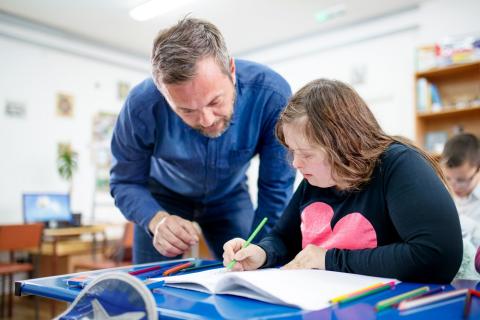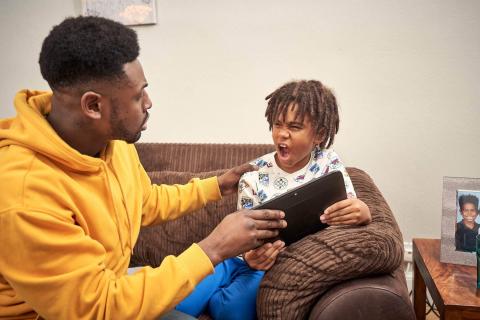You’re not alone if it's a struggle to get their homework done. Whether they’re tired, you’re low on time or you’re just a bit rusty – some days it's just not happening.
The good news is there are easy ways to help your child with maths as part of your daily routine. There are also loads of maths games you can play whether it's a rainy day or you're out and about. Here are some top tips from mums and dads for fun ways to help your child with their maths:
Tips to make maths homework fun
Tip #1: Use maths to explain things they care about
Kids are more likely to learn when they’re interested. For example, if they’re football mad, you could ask them how many players would be left on the field if 2 players are shown the red card. If they love Lego, you could ask them to use blocks to help them count – if they start with 20 blocks and you take away 3, how many are left?
Tip #2: Get baking!
Baking is a brilliant way to get your child doing maths without even realising it. Here are some ideas for helping them with maths in the kitchen – you could try these while making a snack together after school, like banana bread or apple flapjacks.
Here are some ideas for helping them with maths in the kitchen:
- Count the eggs, bananas, apples and other items going into the mix
- Talk to your child about what you’re doing – show them the numbers you’re using to help you cook from the recipe and ask if they can read any to you. Tell them how you’re using them, for measuring the flour and setting the temperature on the oven.
- You could ask them to help you set some of the numbers – like the dial on the oven, or a stopwatch on your phone.
If your child is further along with their maths, you can help them to:
- Measure the flour and sugar.
- Work out what size of cake tin you need – for square tins, they could use a ruler.
- Convert minutes into hours.
- Double the recipe.
- Set the timer and read the numbers to you as they go down.
- Use a clock to work out when your baking will be ready.
Tip #3: Take them shopping
Keep them busy during the shop by getting them to write a mini shopping list of something they’re going to help you make. Ask them add up how much it will cost as they go around. Can they work out what the correct change will be? You could even show them 2 different sizes of the same product and see if they can work out which is better value.
Tip #4: Back-to-back
To help your child learn about shapes and symmetry, draw half of a picture (e.g. the outline of a butterfly, a ladybird, an octopus or a house) and get them to draw the other side. Swap roles so they draw the first half of the picture and you have to finish the drawing. Looking at emojis is another fun way to discuss symmetry – which ones are symmetrical and which are not?
Tip #5: How heavy?
Get out some kitchen or bathroom scales and start measuring different items around your house. For older kids – what can they put together that will add to 2kg? 100g?
Tip #6: Ahoy there matey!
Get some newspaper and make some pirate hats together. Show your child the triangles and how they fit together. Talk about how they’re the same on both sides , which means they’re symmetrical. Then go conquer the seven seas!
Tip #7: Times tables
The real trick to learning times tables is understanding what they mean. Getting some objects will help your child to learn it – and let’s be honest, probably help most of us to re-learn it!
For the:
- 2 times table - use ten 2p coins
- 3 times table – cut out 10 triangles and count the sides
- 4 times table – cut out 10 squares and count the sides
- 5 times table – use ten 5p coins
- 6 times table – cut out hexagons and count the sides
- 7 times table – draw around a 20p to give ten heptagons and count the sides
- 8 times table – draw or make ten octopi and count the tentacles
- 9 times table – draw or make ten 9 spotted ladybirds and count the spots
- 10 times table – use 10p coins
Tip #8: Piggy bank
Rummage through your pockets, wallet or a piggy bank until you have a good selection of coins from 1p to £2. What is the best way to count all of the money? Piles of ten? Big coins first? Putting all the same values together? Start with a few coins and then add more, depending on your child’s confidence.
Tip #9: Set the table
Get your child to share the food out for everyone equally. For older children – can they work out how much needs to go on everyone's plate if they share out different portions (e.g. a third for the baby?). For younger children – can they count out how many plates, knives and forks will need to go out?
Tip #10: Receipt run-down
If you keep receipts, give them to your child and ask them to put them in order for you. It will help them to learn about things like decimal places. Ask if they can help you by telling you if some items were cheaper than others.
Tip #11: Who has the longest?
Ask your child to see who in your family has the longest legs, the shortest hair, largest hand span, etc. Ask them to guess first, and then measure with a ruler. Ask them to write it down as 152 cm, 1.52m, or 1m 52cm.
Tip #12: World records
Ask your child to see how long it takes them to do different things – get dressed, clean their room, do 10 star jumps, write their name, draw circles, draw as many straight lines as they can, or play their favourite games. Get them to write down their answers and compare with how long it takes them the next time. Why not time how long it takes you to do the same things and compare?
Tip #13: Bank bargains
Collect up as many 2p, 5p and 10p coins as you can. Ask your child “If I give you six 2ps, how much is that?” “How many 2ps can you give me for 16p?” “I’ve got ten 5ps, how many 10ps will you swap me for them?” “What is best to have, three 5ps, or eight 2ps?” At first, just use one value of coin, and then add in more as your child gets more confident.
Tip #14: Count the carrots
If you've got a game or toys that come with lots of different pieces – like building blocks, or toy cards – you could use these to help your child share out items into equal groups – 5 for you, 5 for me, and so on. It teaches them about sharing AND counting. Win win!
Top #15: Sweet treats
Counting doesn’t have to be tricky – all it takes is a fruit salad. Get them to count out 3 grapes, or 4 strawberries or 5 blueberries for each of you. Then get them to find out what happens if they have 6 grapes and give 3 away.
Tip #16: Having fun outside

Homework doesn’t need to be something you do inside – take it outside by getting them to count what they see on the way to school, counting throws at the park, or even playing football together. You can find more games to keep them entertained that will help them with their maths here.
Tip #17: Wind down to bedtime
Bring some counting games into your bedtime routine, like reading the clock so they know it’s time for bed and 2 minutes of brushing their teeth and. Find more tips for counting down to bedtime here.
Maths games to play together
Game #1: Snakes & ladders
Playing games together like Snakes & Ladders, Connect 4 and Bingo all help them with addition and subtraction. Here are more free games you can play on a rainy day that will help them with their maths.
Game #2: I'm thinking of a number
A good game to play in the car! Ask them to guess a number you’re thinking of between 0 and 20. Is the number higher or lower? Is it odd or even? Is it a multiple of...
Game #3: Play shop keepers
A fun game for a rainy day! Get some Post-it notes and label items from around the house like their favourite toys with prices up to 50p. Items can be multiples of 5, 10 or 1p depending on how confident your child is at maths. Pay them with real money or “Post-it money” and get your little “shop keeper” to give you accurate change. Swap and repeat!
Game #4: Robot shapes
Play together after school by drawing robots with shapes. Use an old food box or greetings card to make a range of 2D shapes. Draw shapes like squares, rectangles, triangles, pentagons, hexagons, and octagons. You can draw around cans, coins etc for different circles.
Cut out the shapes and use them as templates to create pictures. Can you work together to draw a robot?
Game #5: Make a magic potion
With your child, collect up somethings around the house you could use to make a magic potion, like washing up liquid, food colouring, soap and paint. Then find some different containers, like empty bottles and jam jars. Try mixing together the “magic ingredients” in the containers with some water from a measuring jug. While you’re making your potions, you can talk to them about how much water you need to fill each container. When is the container half full? When is it three-quarters full?
Top tip: keep it fun!
Don't worry if your child gets the answer wrong. Let them know it's not a big deal. Try to praise their effort rather than them getting answers right. That way, they'll get more confident at trying to solve things, even if they don't come up with the right answer straight away.
 Activities & Play
Activities & Play Behaviour
Behaviour Childcare
Childcare Development & Growing Up
Development & Growing Up Family, Friends & Relationships
Family, Friends & Relationships Feeding Your Baby
Feeding Your Baby Food & Eating
Food & Eating Health & Safety
Health & Safety Mental Health & Wellbeing
Mental Health & Wellbeing Money & Work
Money & Work Online Behaviour & Safety
Online Behaviour & Safety Pregnancy & First Days
Pregnancy & First Days School & Education
School & Education Sleep
Sleep










 Online Behaviour & Safety
Online Behaviour & Safety
 Childcare
Childcare